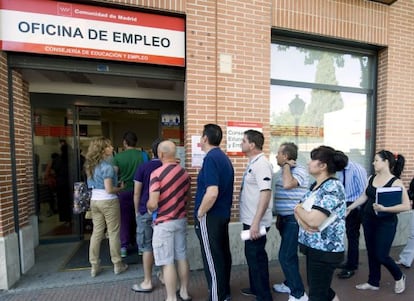Spanish economy records biggest quarterly jobs rise since 2005
Unemployment rate falls to 22.37% between April and June after creating 411,800 positions

Spain’s unemployment rate went down to 22.37% in the second quarter of the year, according to the National Statistics Institute’s (INE) latest Active Population labor force survey, which calculates jobless figures using International Labour Organization (ILO) standards.
Between April and June the Spanish economy created 411,800 jobs, a quarterly increase of 2.36%, leaving the total number of people in employment at 17,866,500. Meanwhile, the number of jobless claims fell to 5,149,000.
The second quarter of the year is typically a strong season for the labor market, although this year has been exceptionally good
Although Spain is now expected to be the developed world’s biggest job creator in 2015 and 2016, its unemployment rate has been above 20% since 2010. Some world bodies expect the figure to fall below this threshold by late 2016.
The second quarter of the year is typically a strong season for the Spanish labor market, although this year has been exceptionally good: the jobless rate fell 1.4 percentage points in just three months. At the same time, the 411,800 jobs created in the period reflect the biggest quarterly employment increase since the second quarter of 2005, before the crisis hit.
Occupation grew in all economic sectors: 291,700 jobs were added in services, which includes travel and tourism. Industry registered 64,800 new jobs, followed by construction with 32,300 and agriculture with 23,000.
However, 307,300 of the new jobs were temporary, while only 60,800 long-term contracts were signed. This puts Spain’s temporary jobs level at close to 25%, a figure that international organizations have criticized.
Below the 20% threshold
After years of job destruction caused by the protracted economic crisis that began in 2008, Spain now seems set to bring its soaring unemployment below the 20% mark by the end of next year. The OECD's Employment Outlook 2015 report is positing a figure of 19.7% in the fourth quarter of 2016, although the average annual rate for next year will still be above 20%, a threshold that was reached in 2010, then amply surpassed.
Other world bodies are not as optimistic, however. The International Labor Organization (ILO) feels that Spain's jobless rate will remain at 21.5% as late as 2019, while the International Monetary Fund (IMF) talks about 2017 as the year that Spain will fall below the 20% rate.
In any case, the OECD underscores that Spain's unemployment rate is still "one of the highest" among member states. By comparison, the average rate for OECD countries is under 7%.
This body also criticizes the high number of temporary jobs in Spain, where 24% of workers are on this type of contract, a figure only exceeded by Poland within the OECD community.
Tu suscripción se está usando en otro dispositivo
¿Quieres añadir otro usuario a tu suscripción?
Si continúas leyendo en este dispositivo, no se podrá leer en el otro.
FlechaTu suscripción se está usando en otro dispositivo y solo puedes acceder a EL PAÍS desde un dispositivo a la vez.
Si quieres compartir tu cuenta, cambia tu suscripción a la modalidad Premium, así podrás añadir otro usuario. Cada uno accederá con su propia cuenta de email, lo que os permitirá personalizar vuestra experiencia en EL PAÍS.
¿Tienes una suscripción de empresa? Accede aquí para contratar más cuentas.
En el caso de no saber quién está usando tu cuenta, te recomendamos cambiar tu contraseña aquí.
Si decides continuar compartiendo tu cuenta, este mensaje se mostrará en tu dispositivo y en el de la otra persona que está usando tu cuenta de forma indefinida, afectando a tu experiencia de lectura. Puedes consultar aquí los términos y condiciones de la suscripción digital.
Últimas noticias
Pinochet’s victims grapple with José Antonio Kast’s rise in Chile
Reinhard Genzel, Nobel laureate in physics: ‘One-minute videos will never give you the truth’
How Japan is trying to avert ‘digital defeat’
The complicated life of Francesca Albanese: A rising figure in Italy but barred from every bank by Trump’s sanctions
Most viewed
- Pablo Escobar’s hippos: A serious environmental problem, 40 years on
- Why we lost the habit of sleeping in two segments and how that changed our sense of time
- Trump’s obsession with putting his name on everything is unprecedented in the United States
- Charles Dubouloz, mountaineering star, retires at 36 with a farewell tour inspired by Walter Bonatti
- The Florida Keys tourist paradise is besieged by immigration agents: ‘We’ve never seen anything like this’








































